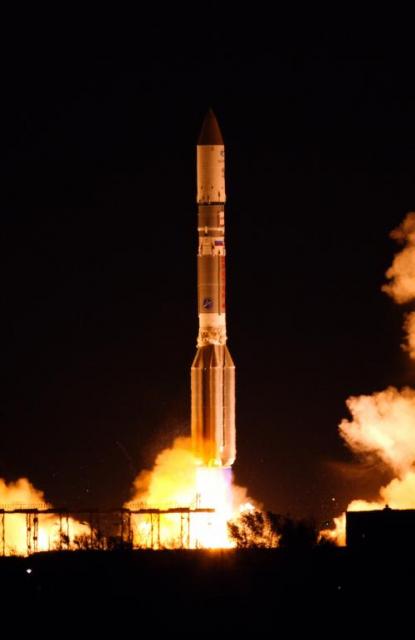Russian Rocket Launches Telecom Satellite

PARIS — An International Launch Services (ILS) Proton Breeze-M rocket on Wednesday (May 15) successfully placed the Eutelsat 3D Ku- and Ka-band telecommunications satellite into transfer orbit in the third of a planned six monthly commercial ILS launches scheduled through August.
Eutelsat announced immediately after the launch that it had signed another contract with Reston, Va.-based ILS, for an unnamed satellite to be orbited between 2014 and 2016. Eutelsat has six satellites under construction and scheduled for launch by late 2015.
Paris-based Eutelsat and satellite builder Thales Alenia Space of France and Italy confirmed that the 5,400-kilogram Eutelsat 3D, carrying 53 Ku-band and three Ka-band transponders, had begun solar array deployment in orbit and had been communicating with ground teams. [50 Great Russian Rocket Launch Photos]
Eutelsat 3D will have a Ku-band beam trained on sub-Saharan Africa, another covering Europe, the Middle East and parts of Central and South Asia, and a Ka-band beam covering most of Europe, Russia and the Middle East.
Operating from Russia’s Baikonur Cosmodrome in Kazakhstan, the Russian Proton Breeze-M vehicle separated the Eutelsat 3D after a mission lasting nine hours and 13 minutes and including five ignition sequences of the Breeze-M upper stage.
ILS President Philip R. Slack, who watched the launch from Eutelsat’s headquarters here, said the company is on track to launch six commercial satellites by August as it returns to flight following a Proton launch anomaly in December.
The Eutelsat launch was the third of these six missions, following launches of the Satmex 8 satellite in March and the Telesat Anik G1 in April. Next up is the SES-6 satellite, owned by SES of Luxembourg, which is scheduled for June, Slack said. SES-6 has already arrived at the Baikonur spaceport.
Get the Space.com Newsletter
Breaking space news, the latest updates on rocket launches, skywatching events and more!
Speaking with journalists after the liftoff, Slack said it will take several more weeks before ILS and its owner, Khrunichev State Research and Production Space Center of Moscow, which is owned by the Russian government and is Proton’s principal manufacturer, to determine the Proton launch manifest after August.
The Russian government is a regular customer for Proton rockets, and the Proton schedule between September and December will depend in part on what satellites are ready, Slack said.
Eutelsat 3D will operate at 3 degrees east in geostationary orbit for about a year. Following the successful launch of the Eutelsat 3B satellite in 2014, Eutelsat 3D will be moved to 7 degrees east, Eutelsat Chief Executive Michel de Rosen said during a presentation to the audience gathered to watch the launch here.
The audience included representatives from the governments of Bolivia and Peru, a signal that Eutelsat, like several other North American and European satellite fleet operators, is eyeing Latin America for part of the company’s future growth plans. Eutelsat has won rights to an orbital slot over Brazil but has not announced its plans there.
This story was provided by Space News, dedicated to covering all aspects of the space industry.
Join our Space Forums to keep talking space on the latest missions, night sky and more! And if you have a news tip, correction or comment, let us know at: community@space.com.

Charles Q. Choi is a contributing writer for Space.com and Live Science. He covers all things human origins and astronomy as well as physics, animals and general science topics. Charles has a Master of Arts degree from the University of Missouri-Columbia, School of Journalism and a Bachelor of Arts degree from the University of South Florida. Charles has visited every continent on Earth, drinking rancid yak butter tea in Lhasa, snorkeling with sea lions in the Galapagos and even climbing an iceberg in Antarctica. Visit him at http://www.sciwriter.us

